Abstract
A model for the opiate receptor has been defined by using a computer-based molecular display and x-ray crystallographic input data. The model can explain the stereochemical fashion in which the morphine, morphinan, and oripavine classes of compounds interact with the receptor. The minimal structural unit of the enkephalins demonstrated to be pharmacologically active. Tyr-Gly-Gly-Phe, was also fitted to this model by using a systematic search of conformational space.
Full text
PDF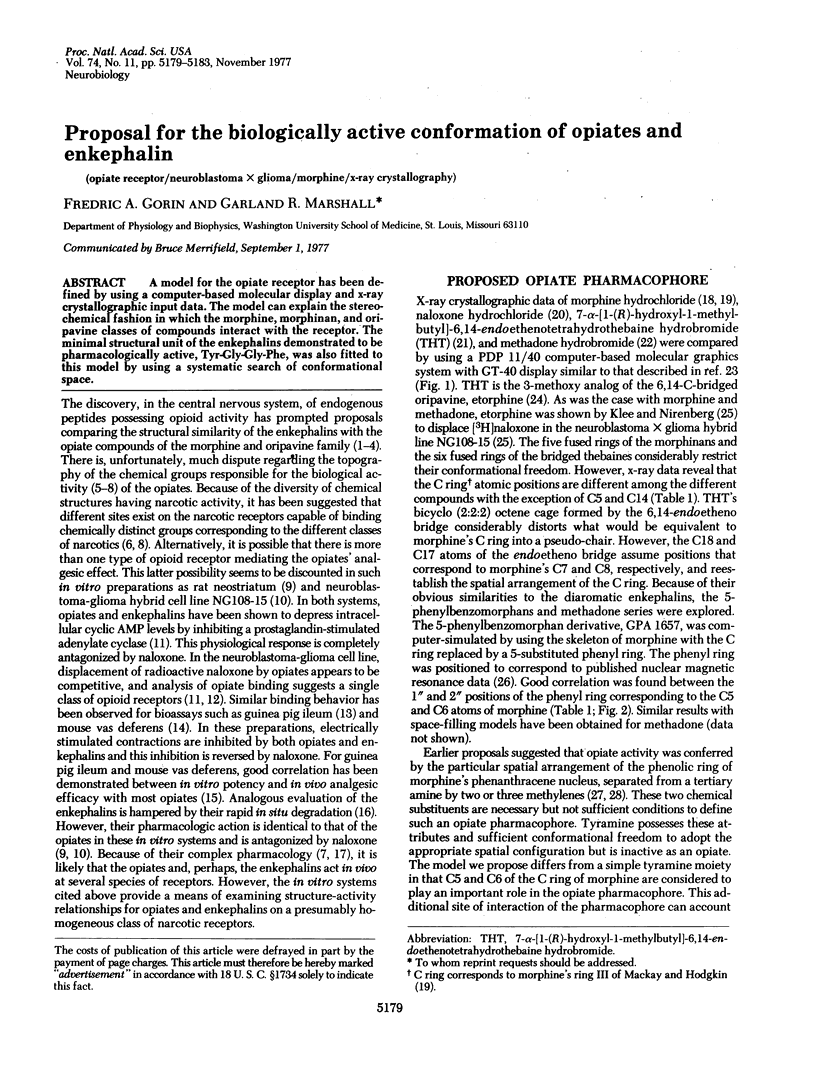
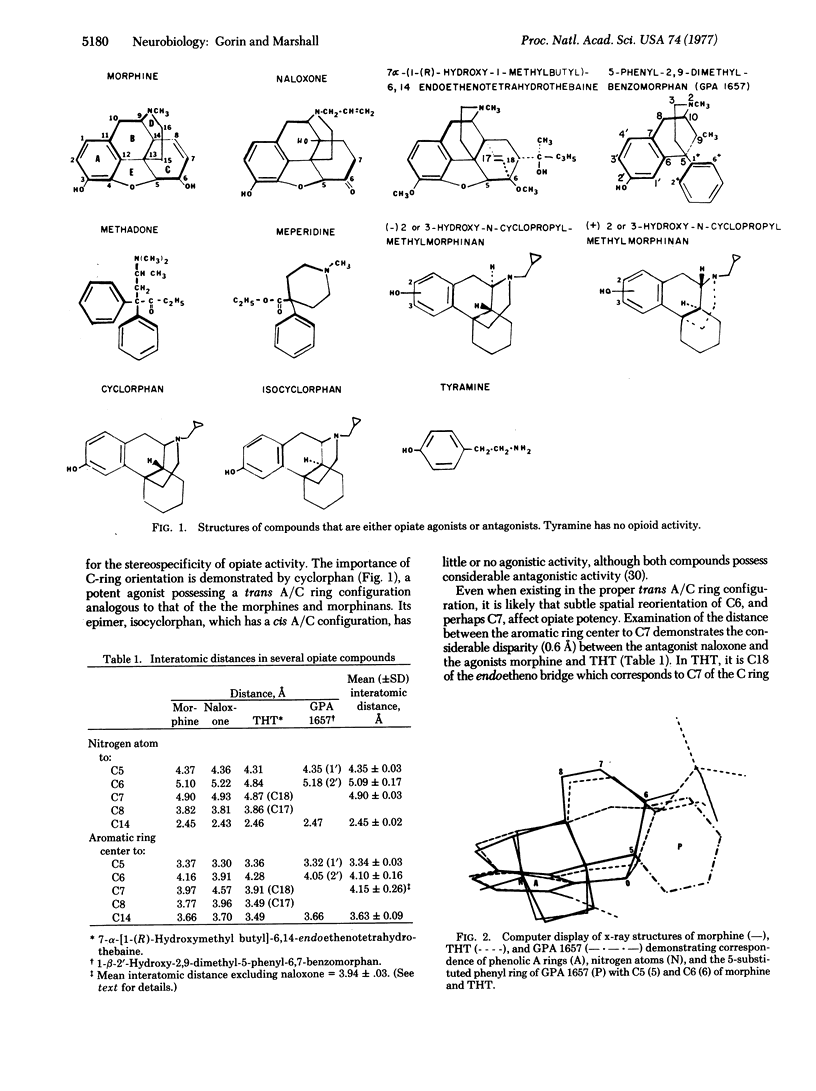
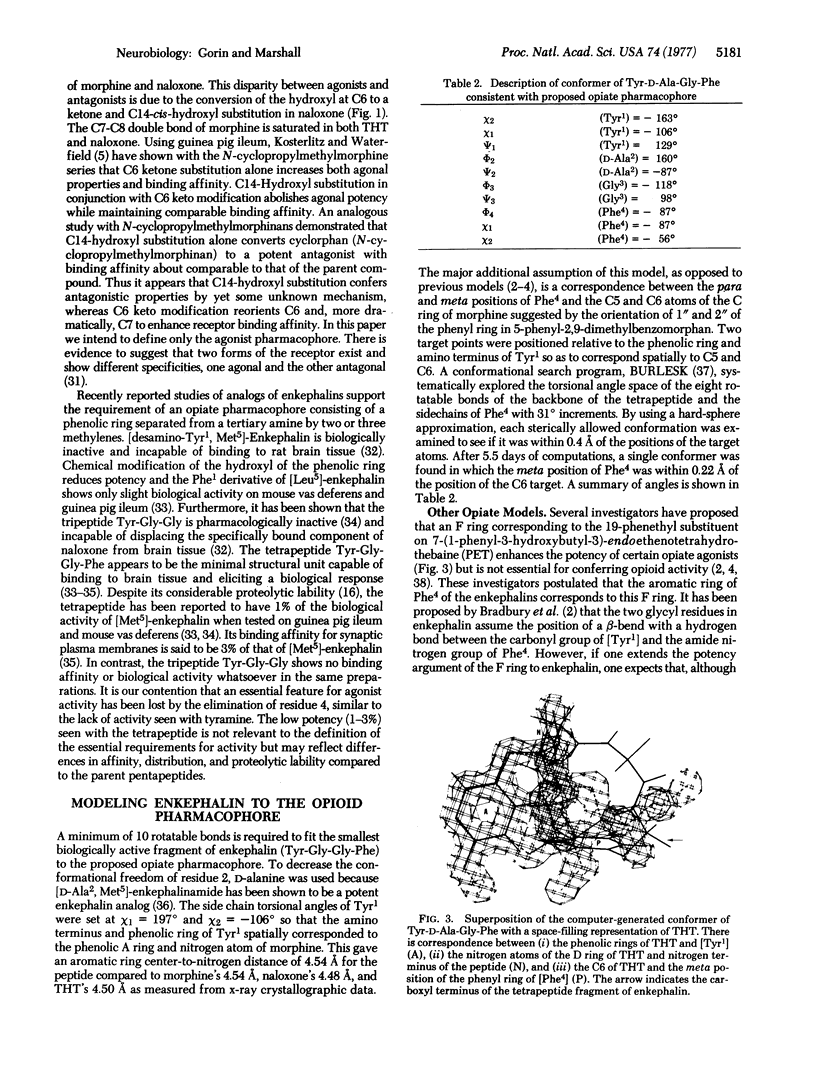
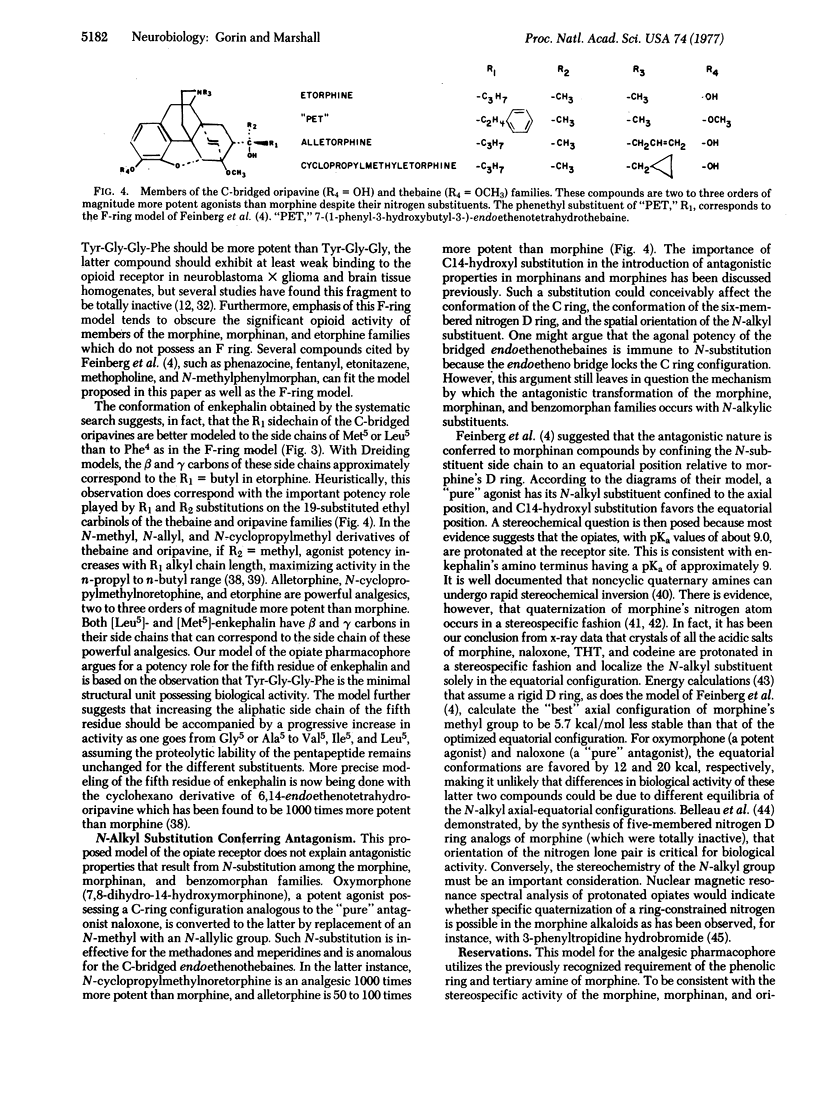
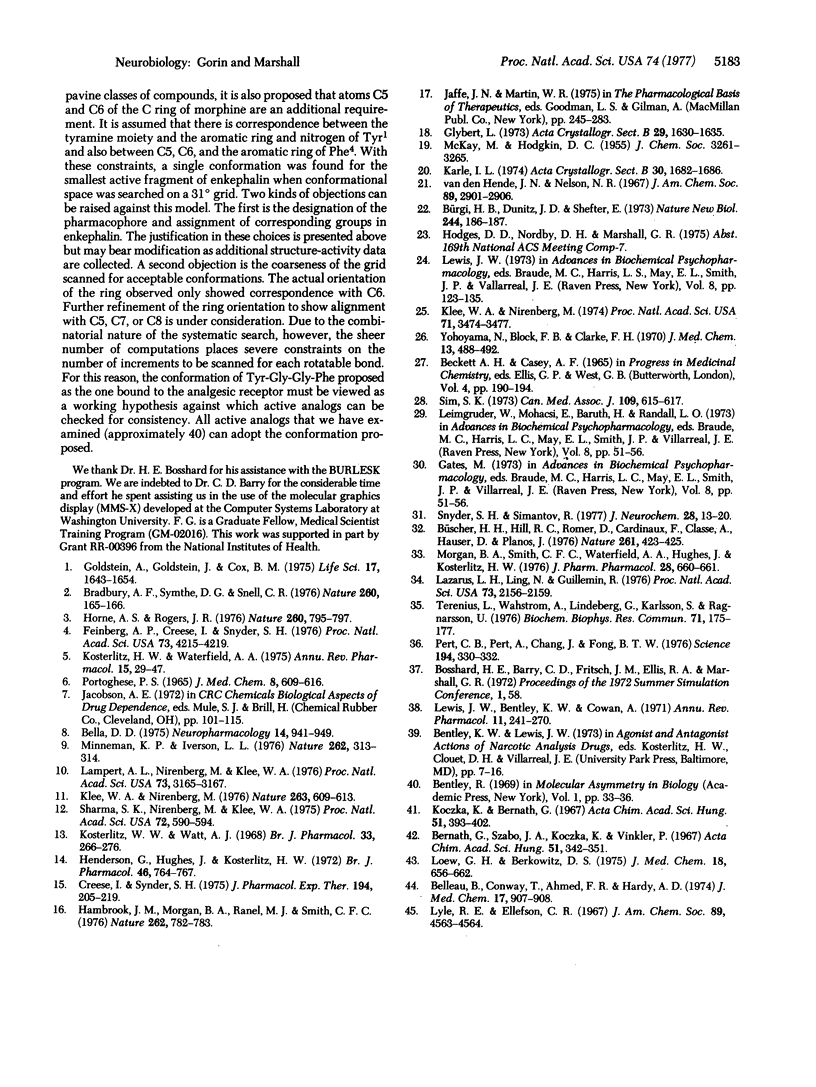
Images in this article
Selected References
These references are in PubMed. This may not be the complete list of references from this article.
- Bella D. D. Structural features associated with narcotics and narcotic antagonists. Neuropharmacology. 1975 Dec;14(12):941–949. doi: 10.1016/0028-3908(75)90048-9. [DOI] [PubMed] [Google Scholar]
- Belleau B., Conway T., Ahmed F. R., Hardy A. D. Importance of the nitrogen lone electron pair orientation in stereospecific opiates. J Med Chem. 1974 Aug;17(8):907–908. doi: 10.1021/jm00254a029. [DOI] [PubMed] [Google Scholar]
- Bradbury A. F., Smyth D. G., Snell C. R. Biosynthetic origin and receptor conformation of methionine enkephalin. Nature. 1976 Mar 11;260(5547):165–166. doi: 10.1038/260165a0. [DOI] [PubMed] [Google Scholar]
- Buscher H. H., Hill R. C., Römer D., Cardinaux F., Closse A., Hauser D., Pless J. Evidence for analgesic activity of enkephalin in the mouse. Nature. 1976 Jun 3;261(5559):423–425. doi: 10.1038/261423a0. [DOI] [PubMed] [Google Scholar]
- Bürgi H. B., Dunitz J. D., Shefter E. Pharmacological implications of the conformation of the methadone base. Nat New Biol. 1973 Aug 8;244(136):186–187. doi: 10.1038/newbio244186b0. [DOI] [PubMed] [Google Scholar]
- Creese I., Snyder S. H. Receptor binding and pharmacological activity of opiates in the guinea-pig intestine. J Pharmacol Exp Ther. 1975 Jul;194(1):205–219. [PubMed] [Google Scholar]
- Feinberg A. P., Creese I., Snyder S. H. The opiate receptor: a model explaining structure-activity relationships of opiate agonists and antagonists. Proc Natl Acad Sci U S A. 1976 Nov;73(11):4215–4219. doi: 10.1073/pnas.73.11.4215. [DOI] [PMC free article] [PubMed] [Google Scholar]
- Goldstein A., Goldstein J. S., Cox B. M. A synthetic peptide with morphine-like pharmacologic action. Life Sci. 1975 Dec 1;17(11):1643–1654. doi: 10.1016/0024-3205(75)90109-5. [DOI] [PubMed] [Google Scholar]
- Hambrook J. M., Morgan B. A., Rance M. J., Smith C. F. Mode of deactivation of the enkephalins by rat and human plasma and rat brain homogenates. Nature. 1976 Aug 26;262(5571):782–783. doi: 10.1038/262782a0. [DOI] [PubMed] [Google Scholar]
- Henderson G., Hughes J., Kosterlitz H. W. A new example of a morphine-sensitive neuro-effector junction: adrenergic transmission in the mouse vas deferens. Br J Pharmacol. 1972 Dec;46(4):764–766. doi: 10.1111/j.1476-5381.1972.tb06901.x. [DOI] [PMC free article] [PubMed] [Google Scholar]
- Horn A. S., Rodgers J. R. Structural and conformational relationships between the enkephalins and the opiates. Nature. 1976 Apr 29;260(5554):795–797. doi: 10.1038/260795a0. [DOI] [PubMed] [Google Scholar]
- Klee W. A., Nirenberg M. A neuroblastoma times glioma hybrid cell line with morphine receptors. Proc Natl Acad Sci U S A. 1974 Sep;71(9):3474–3477. doi: 10.1073/pnas.71.9.3474. [DOI] [PMC free article] [PubMed] [Google Scholar]
- Klee W. A., Nirenberg M. Mode of action of endogenous opiate peptides. Nature. 1976 Oct 14;263(5578):609–612. doi: 10.1038/263609a0. [DOI] [PubMed] [Google Scholar]
- Kosterlitz H. W., Waterfield A. A. In vitro models in the study of structure-activity relationships of narcotic analgesics. Annu Rev Pharmacol. 1975;15:29–47. doi: 10.1146/annurev.pa.15.040175.000333. [DOI] [PubMed] [Google Scholar]
- Lampert A., Nirenberg M., Klee W. A. Tolerance and dependence evoked by an endogenous opiate peptide. Proc Natl Acad Sci U S A. 1976 Sep;73(9):3165–3167. doi: 10.1073/pnas.73.9.3165. [DOI] [PMC free article] [PubMed] [Google Scholar]
- Lazarus L. H., Ling N., Guillemin R. beta-Lipotropin as a prohormone for the morphinomimetic peptides endorphins and enkephalins. Proc Natl Acad Sci U S A. 1976 Jun;73(6):2156–2159. doi: 10.1073/pnas.73.6.2156. [DOI] [PMC free article] [PubMed] [Google Scholar]
- Lewis J. W., Bentley K. W., Cowan A. Narcotic analgesics and antagonists. Annu Rev Pharmacol. 1971;11:241–270. doi: 10.1146/annurev.pa.11.040171.001325. [DOI] [PubMed] [Google Scholar]
- Loew G. H., Berkowitz D. S. Quantum chemical studies of morphine-like opiate narcotics. Effect of N-substituent variations. J Med Chem. 1975 Jul;18(7):656–662. doi: 10.1021/jm00241a002. [DOI] [PubMed] [Google Scholar]
- Minneman K. P., Iversen I. L. Enkephalin and opiate narcotics increase cyclic GMP accumulation in slices of rat neostriatum. Nature. 1976 Jul 22;262(5566):313–314. doi: 10.1038/262313a0. [DOI] [PubMed] [Google Scholar]
- Morgan B. A., Smith C. F., Waterfield A. A., Hughes J., Kosterlitz H. W. Structure-activity relationships of methionine-enkephalin. J Pharm Pharmacol. 1976 Aug;28(8):660–661. doi: 10.1111/j.2042-7158.1976.tb02827.x. [DOI] [PubMed] [Google Scholar]
- Pert C. B., Pert A., Chang J. K., Fong B. T. (D-Ala2)-Met-enkephalinamide: a potent, long-lasting synthetic pentapeptide analgesic. Science. 1976 Oct 15;194(4262):330–332. doi: 10.1126/science.968485. [DOI] [PubMed] [Google Scholar]
- Portoghese P. S. A new concept on the mode of interaction of narcotic analgesics with receptors. J Med Chem. 1965 Sep;8(5):609–616. doi: 10.1021/jm00329a013. [DOI] [PubMed] [Google Scholar]
- Sharma S. K., Nirenberg M., Klee W. A. Morphine receptors as regulators of adenylate cyclase activity. Proc Natl Acad Sci U S A. 1975 Feb;72(2):590–594. doi: 10.1073/pnas.72.2.590. [DOI] [PMC free article] [PubMed] [Google Scholar]
- Sim S. K. Methadone. Can Med Assoc J. 1973 Oct 6;109(7):615–619. [PMC free article] [PubMed] [Google Scholar]
- Snyder S. H., Simantov R. The opiate receptor and opoid peptides. J Neurochem. 1977 Jan;28(1):13–20. doi: 10.1111/j.1471-4159.1977.tb07703.x. [DOI] [PubMed] [Google Scholar]
- Terenius L., Wahlström A., Lindeberg G., Karlsson S., Ragnarsson U. Opiate receptor affinity of peptides related to Leu-enkephalin. Biochem Biophys Res Commun. 1976 Jul 12;71(1):175–179. doi: 10.1016/0006-291x(76)90265-5. [DOI] [PubMed] [Google Scholar]
- van den Hende J. H., Nelson N. R. The crystal and molecular stucture of 7-alpha-(1-(r)-hydroxy-1-methylbutyl)-6,14-endo-ethenotetrahydrothebaine hydrobromide (19 -propylthevinol hydrobromide). J Am Chem Soc. 1967 Jun 7;89(12):2901–2905. doi: 10.1021/ja00988a017. [DOI] [PubMed] [Google Scholar]



